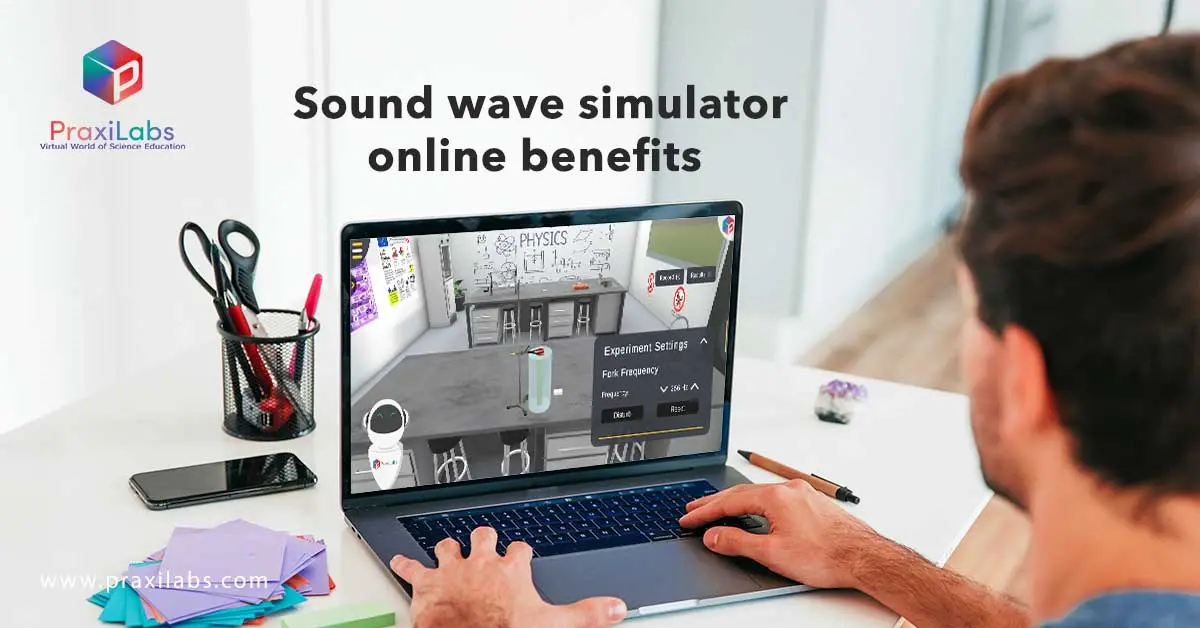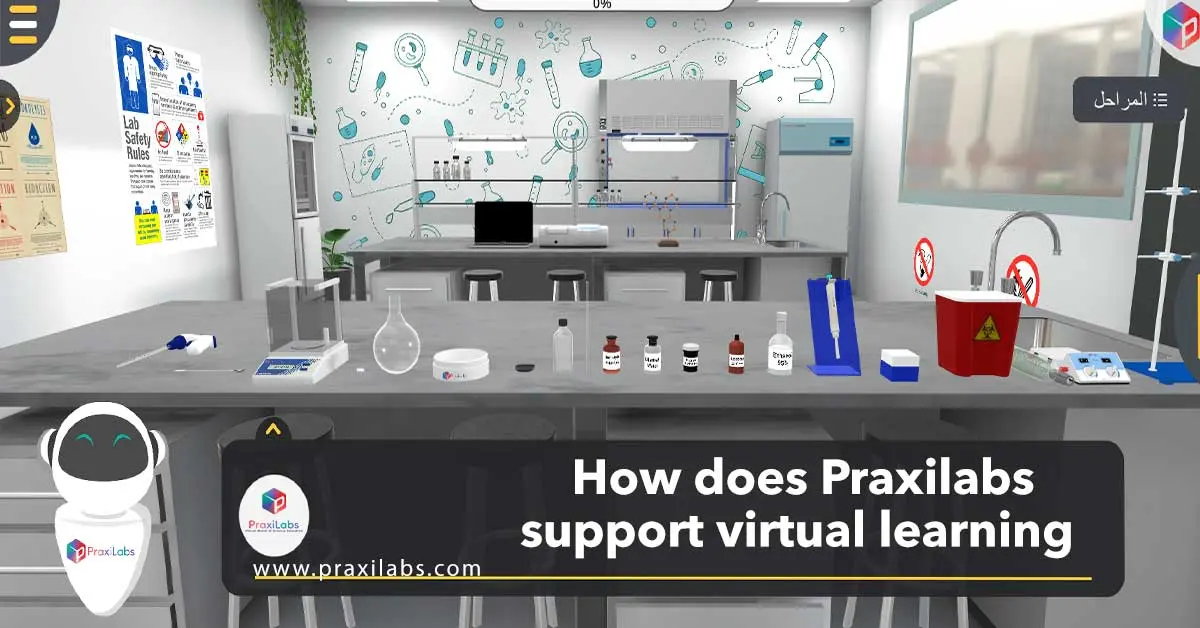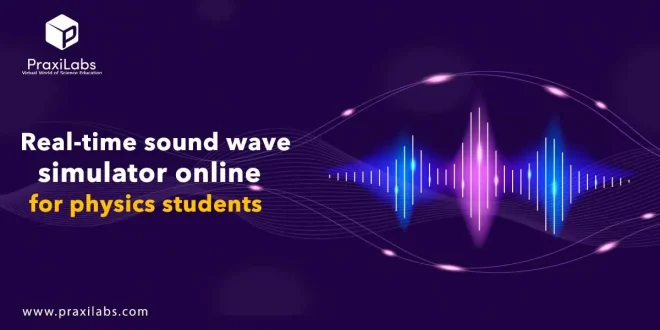Last Updated on October 8, 2025 by Muhamed Elmesery
Learning about sound waves can feel abstract when all students have is formulas and diagrams. A real-time sound wave simulator online changes that by turning theory into something visible and interactive.
Physics students can experiment with frequency, amplitude, resonance, and even the Doppler effect—watching wave patterns respond instantly to their input.
This hands-on experience makes concepts like pitch, loudness, and interference not only easier to grasp but also more engaging, bridging the gap between textbook physics and the sounds we hear every day.
Table of Contents
What is a sound wave simulator?
A sound wave simulator is a computer-based environment that simulates the phenomena of sound waves which are mechanical, longitudinal waves traveling through an elastic medium. The source of sound waves is a vibrating object such as a loudspeaker or a tuning fork. The air (or any other elastic medium) in the path of the sound wave becomes alternately denser and rarer.
When the molecules are forced closer together than normal, the region of higher density is called a compression, whereas the region of lower density is called a rarefaction.
By using sound simulator that simulate sound waves, students can learn how different sounds are modeled, described, and produced by designing ways to determine the speed, frequency, period, and wavelength of a sound wave model.
Sound wave simulator online learning concepts
The following table summarizes the key learning concepts of a sound wave simulator:
| Concept | What Students Learn | How the Simulator Helps | Real-World Example |
| Nature of Sound | Sound is a mechanical, longitudinal wave requiring a medium. | Visualizes compressions and rarefactions. | Vibrations from a tuning fork. |
| Wave Properties | Frequency, amplitude, wavelength, and speed of sound. | Students adjust values and see changes instantly. | Speed of sound in air vs. water. |
| Pitch & Loudness | Pitch depends on frequency; loudness depends on amplitude. | Direct cause-and-effect through sliders or controls. | Musical notes and speaker volume. |
| Interference & Superposition | Waves can combine (constructive) or cancel (destructive). | Overlapping waves are shown graphically. | Noise-cancelling headphones. |
| Resonance | Natural frequency causes maximum vibration. | Demonstrates resonance in air columns or strings. | Organ pipes, guitar strings. |
| Doppler Effect | Frequency changes when source or observer moves. | Simulates moving sound sources. | Siren of an ambulance passing by. |
| Applications of Sound | Uses of sound in technology and nature. | Links abstract physics to practical uses. | Ultrasound imaging, echolocation. |
| Interactive Learning | Builds intuition, links math with physics, allows safe experiments. | Students manipulate variables and test scenarios. | Virtual labs replacing physical constraints. |
Read Also: Physics Wave Simulator to Master all Waves Properties

Sound wave simulator online benefits
Using sound wave simulator online provides several features for both students and educational institutions, Here are why it’s valuable:
-
Visualizing Invisible Concepts
By using virtual physics lab, sound waves can seem abstract. Simulators make sound wave behavior visible — like interference and reflection, which helps students understand more deeply.
-
Safe and Cost-Effective
There is no need for expensive real lab equipment, your students can perform their sound wave simulation experiments using their devices.
No risk of hazards (e.g., electrical, thermal, or laser hazards).
-
Interactive Learning
Students learn wave concepts in an immersive and interactive environment. They can change variables like frequency and instantly see the result.
Using virtual labs enhances critical thinking skills and active learning, not just passive observation.
How do sound simulation help in teaching waves interference and beats?
Sound simulations make invisible wave phenomena visible, audible, and interactive, helping students:
- Grasp interference intuitively.
- Experience beats in real time.
- Connect math, sound, and physics in a unified way.

What features are included in PraxiLabs’ sound simulations?
Immersive Interaction
PraxiLabs provides 3D sound wave labs that simulate real labs to enhance attention, engagement, and hands-on learning.
Mobility and Accessibility
PraxiLabs sound wave simulation software is accessible anytime, anywhere—on desktops, tablets, and smartphones.
Feedback & Progress Tracking
While performing sound simulation physics, students receive hints, model answers, and feedback at every stage. Instructors track progress in real time with detailed insights.
Scalable & Customizable
We offer flexible solutions that can be tailored to match your institutional goals, curriculum standards, and diverse student needs.
Cost-Effectiveness
PraxiLabs significantly reduces the expense of traditional labs while providing a complete and impactful learning experience.
Question Bank
The question bank in PraxiLabs gives instructors the tools to design rigorous, customized assessments that align seamlessly with wave course objectives and learning outcomes.
This feature empowers educators to go beyond generic quizzes, providing flexibility, fairness, and control in evaluating student progress— ensuring assessments are not only accurate, but also interactive and personalized to learners’ needs.
Examples of Praxilabs’ sound waves simulations
Closed Air Columns
Aim: To determine the speed of sound in air.
By the end of the experiment, the student should be able to:
- Recognize the nature of sound waves.
- Set up an experiment to study the resonance phenomenon in closed air columns
- Differentiate between types of waves.
- Explain how standing waves can be generated in closed air columns.
- Explain the occurrence of the resonance phenomenon in closed-air columns.
Explore: Speed of Sound Simulation – Using Closed Columns
Open-Air Columns Aim
Aim: To determine the speed of sound in air at room temperature.
By the end of the experiment, the student should be able to:
- Explain the resonance phenomenon.
- Set up an experiment to study the resonance phenomenon in open air columns.
- Determine the speed of sound in air at room temperature using open air columns
Explore: Speed of Sound Virtual Lab – Using Open Columns
Frequently Asked Questions
How do you visualize sound waves as they travel?
For example, by using a microphone the sound waves can be converted into an electrical signal, so you visualize sound waves as they travel.
Is it possible to watch sound waves?
Not directly, but by using virtual lab simulation that simulates the sound waves you can watch it.
 PraxiLabs A virtual world of science
PraxiLabs A virtual world of science






